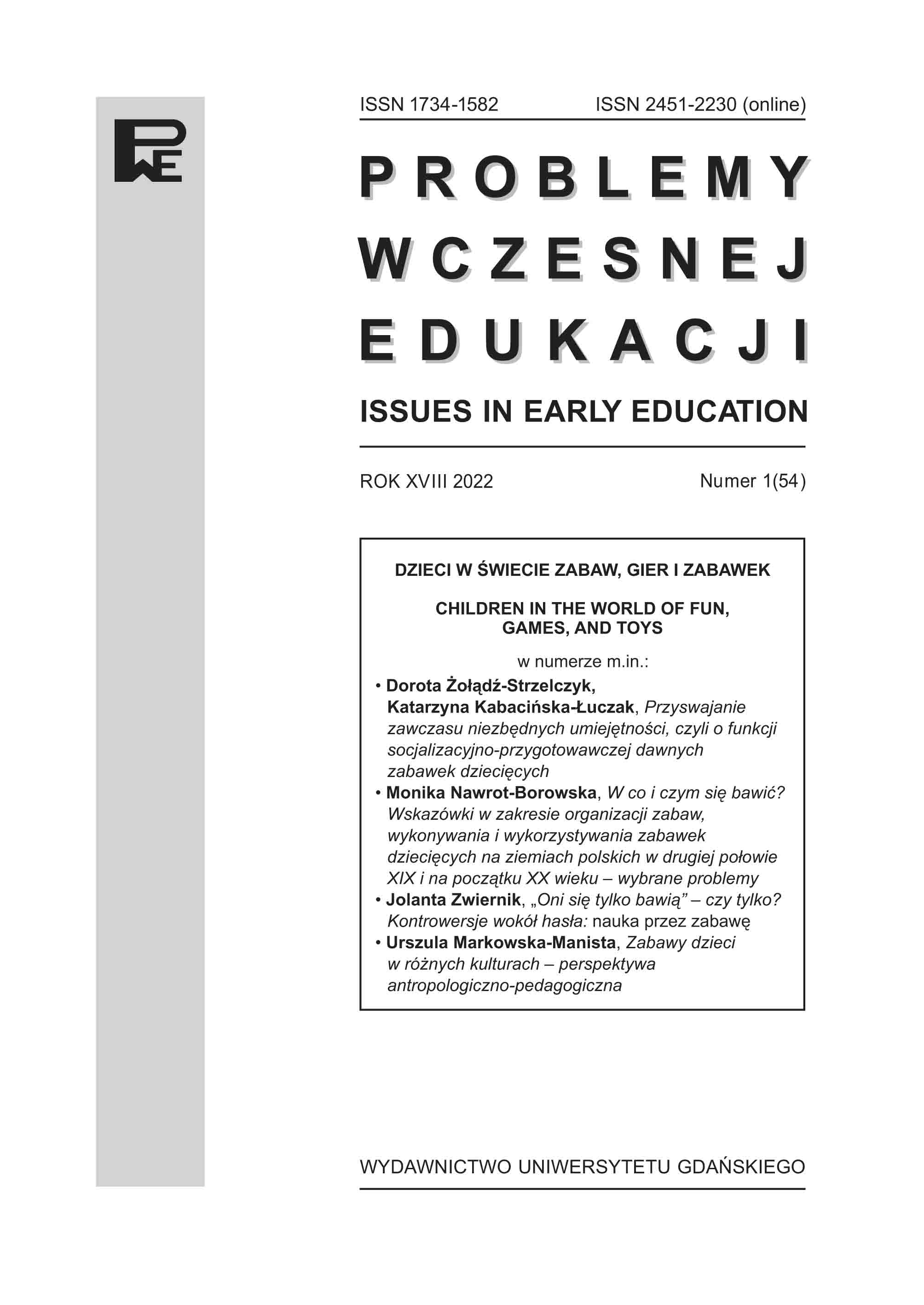Ekscytujący strach – zabawa ryzykowna w opinii rodziców
DOI:
https://doi.org/10.26881/pwe.2022.54.12Słowa kluczowe:
zabawa ryzykowna, opinie rodzicielskie, dziecko w wieku przedszkolnymAbstrakt
The paper concerns the issue of risky play, previously unknown in Poland. It presents an overview of the findings to date in this area and the results of preliminary quantitative research. When designing the study, we took into account the fact that there are noticeable cultural differences in the attitude to risky play (Guldberg 2009), therefore the aim was to find out about the opinions of Polish parents about this type of activity. The study uses the method of a diagnostic survey conducted with the use of the questionnaire technique. The research trial included one hundred parents of children attending big-city kindergartens. Defining risk by parents (dramatizing it or marginalizing it) determines the limits of acceptable activities, it is a manifestation of power, therefore it is important to consciously approach the issue of risky play. The obtained preliminary data indicate a clear division of the respondents into two groups: parents who are cautiously trusting and parents full of anxiety. In the light of the results, an important problem is the potential of typical playgrounds that do not allow participation in risky play, and the lack of access to tools that could be used in such activities.
Downloads
Bibliografia
Beck U. (2004), Społeczeństwo ryzyka. W drodze do innej nowoczesności. Warszawa, Wydawnictwo Naukowe Scholar.
Beck U. (2012), Społeczeństwo światowego ryzyka. W poszukiwaniu utraconego bezpieczeństwa. Warszawa, Wydawnictwo Naukowe Scholar.
Bjorklund D.F., Pellegrini A.D. (2002), The origins of human nature: Evolutionary developmental psychology. Washington, American Psychological Association.
Bruner J.S. (1966), W poszukiwaniu teorii nauczania. Warszawa, PIW.
Brussoni M., Olsen L., Pike I., Sleet D. (2012), Risky Play and Children’s Safety: Balancing Priorities for Optimal Child Development. „International Journal of Environmental Research and Public Health”, 9(9).
Coster D., Gleeve J. (2008), Give us a go! Children and young people’s views on play and risk-taking.https://www.playday.org.uk, 25.11.2021.
Erikson E.H. (1997), Dzieciństwo i społeczeństwo. Poznań, Dom Wydawniczy Rebis.
Erikson E.H., Erikson J.M. (2012), Dopełniony cykl życia. Gliwice, Helion.
Gill T. (2007), No fear: Growing up in a risk averse society. London, Calouste Gulbenkian Foundation.
Gray P. (2015), Wolne dzieci. Jak zabawa sprawia, że dzieci są szczęśliwsze, bardziej pewne siebie i lepiej się uczą? Kraków, Znak.
Guldberg H. (2009), Reclaiming childhood: Freedom and play in an age of fear. New York, Routledge.
GUS (2021), Stan zdrowia ludności Polski w 2019 r. Warszawa, Zakład Wydawnictw Statystycznych.
Huizinga J. (1985), Homo ludens. Zabawa jako źródło kultury. Warszawa, Czytelnik.
Hüttenmoser M. (1995), Children and their living surroundings: Empirical investigation into the significance of living surroundings for the everyday life and development of children. „Children’s Environments”, 12(4).
Janik A. (2021), Podwórkowe przestrzenie i miejsce zabaw. Studium pedagogiczno-kulturowe. Wro -cław, Instytut Pedagogiki Uniwersytetu Wrocławskiego.
Little H., Sandseter E.B.H., Wyver S. (2012), Early Childhood Teachers’ Beliefs about Children’s Risky Play in Australia and Norway. “Contemporary Issues in Early Education”, 13(4).
Mielicka-Pawłowska H. (2014), Homo ludens a sacrum. „Zabawy i Zabawki. Studia Antropologiczne”, 12(1–4).
Nalaskowski A. (2006), Dzikość i zdziczenie jako kontekst edukacji. Kraków, Oficyna Wydawnicza „Impuls”.
Niehues A., Bundy A., Broom A., Tranter P. (2013), Parents’ Perceptions of Risk and the Influence on Children’s Everyday Activities. „Journal of Child and Family Studies”, 24(3).
Sando O.J., Kleppe R., Sandseter E.B.H. (2021), Risky Play and Children’s Well‐Being, Involvement and Physical Activity.„Child Indicators Research”, 14(7).
Sandseter E.B.H. (2010), Scaryfunny – A qualitative study of risky play among preschool children.Thesis for the degree Philosophiae Doctor. Trondheim, Norwegian University of Science and Technology.
Sandseter E.B.H., Kleppe R., Sando O.J. (2021), The Prevalence of Risky Play in Young Children’s Indoor and Outdoor Free Play.„Early Childhood Education Journal”, 49(6).
Stephenson A. (2003), Physical risk-taking: Dangerous or endangered? „Early Years”, 23(1).
Tandy C.A. (1999), Children’s Diminishing Play Space: a Study of Inter-generational Change in Children’s Use of their Neighbourhoods.„Geographical Research”, 37(2).
Valentine G. (1997), “Oh Yes I Can.” “Oh No You Can’t”: Children and Parents’ Understandings of Kids’ Competence to Negotiate Public Space Safely. „Antipode”, 29(1).
Waloszek D. (2006), Pedagogika przedszkolna: metamorfoza statusu i przedmiotu badań. Kraków, Wydawnictwo Naukowe Akademii Pedagogicznej.
Zwiernik J. (2020a), Plac zabaw jako miejsce dla dzieci vs miejsce dzieci. „Problemy Wczesnej Edukacji”, 3(50).
Zwiernik J. (2020b), Przedszkolny plac zabaw z perspektywy dzieci. „Problemy Wczesnej Edukacji”, 3(50).

 Uniwersyteckie Czasopisma Naukowe
Uniwersyteckie Czasopisma Naukowe





